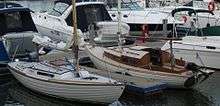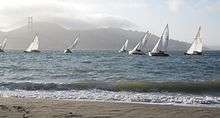Nordic Folkboat
|
Class symbol | |
 | |
| Development | |
|---|---|
| Designer | Tord Sundén |
| Year | 1942 |
| Boat | |
| Crew | 2–3 |
| Draft | 1.20 m (3 ft 11 in) |
| Hull | |
| Hull weight | 1,930 kg (4,250 lb) |
| LOA | 7.68 m (25 ft 2 in) |
| LWL | 6.00 m (19 ft 8 in) |
| Beam | 2.20 m (7 ft 3 in) |
| Hull Appendages | |
| Ballast | 1,050 kg (2,310 lb) |
| Sails | |
| Mainsail area | 17.0 m2 (183 sq ft) |
| Jib / Genoa area | 7.0 m2 (75 sq ft) |
The Nordic Folkboat is a small sailboat, rigged as a sloop. The design of this boat was the result of a competition held by the Scandinavian Yacht Racing Union in 1942, who were hoping to create an easily sailed and low-cost boat. The competition produced no outright "winner " but, taking the best features of a number of the entries received, the organisers commissioned professional designer Tord Sundén to create a craft that met the goals of the design competition. The resulting boat went on to become an international favorite of sailors and still endures more than 70 years after its design. The first Nordic Folkboat was built in Gothenburg in Sweden, and as of 2007, more than 4000 Nordic Folkboats are still sailing around the world.
Design

The Nordic Folkboat, as initially designed, is constructed of wood in the clinker or lap-strake method of boat building. The boat was designed to be built with oak framing and fir planking, although different builders used many different species of wood. The boat has an open cockpit and a low coachroof covering a small cabin usually consisting of two bunks and minimal storage furniture. The boat is rigged as a simple fractional sloop, with minimal standing rigging, consisting only of two lower shrouds, two jumper shrouds, a headstay, and a backstay. Despite the simplicity of the rigging, the mast is highly tunable, enabling the Folkboat to sail well in light and heavy air well beyond initial expectations.
Its iron ballast keel represents more than half of this displacement, making the Folkboat extremely stiff and seaworthy, and it is one of the smallest craft to have made regular ocean crossings and circumnavigations.
Evolution

In 1966, Tord Sundén introduced the carvel-planked “International Folkboat”. This design corresponded largely to the original, but it offered more comfort below deck, and it had a self-bailing cockpit. However, the term “International Folkboat” was too misleading and was forbidden. Today, the class is simply called “IF-boat.” The IF-boat was manufactured at Marieholms Bruk in Småland (Sweden) until 1984.
In 1968, the Folkboat successfully made the transition from traditional clinker timber to modern molded GRP (fiberglass) construction ... retaining the characteristic simplicity of the design. In 1975, Erik Andreasen, a Dane, introduced a GRP replica of the original design ... the mold being taken from his own Tibbe which won the Gold Cup that year. Weights and measurements were carefully preserved to ensure level competition with wooden boats, and only an outboard engine was provided. The type is called the Nordic Folkboat.
A newly built fiberglass Folkboat is an exact replica of the original Folkboat ... and today, wooden and GRP boats race together. The class rules are administrated by the Folkboat International Association. The largest international regattas are: Gold Cup (an unofficial world championship), Sessan Cup (a team race), Kieler Woche and San Francisco Cup. There are active fleets in Denmark, Sweden, Germany, United Kingdom, Ireland, Finland, USA, Canada, the Netherlands, Belgium and Estonia.
Long distance capabilities
In the 1950s, the Folkboat began to attract the attention of long-distance voyagers for its modest cost and seaworthiness.
- Ann Gash from Australia, who made a single-handed circumnavigation in Ilimo between 1975 and 1977.
- 1962/1963 Adrian Hayter sailed single handed from the U.K. to New Zealand in 'Valkyr' by the Westward/Panama route.
- Lt. Col. H.G. "Blondie" Hasler sailed a greatly modified folkboat Jester to second place in the first Observer Singlehanded Trans Atlantic Race in 1960.
- Mike Richie sailed Jester in several Singlehanded Trans Atlantic Races until Jester was damaged and lost at sea. Richie survived and competed for many years in a replica of Jester.
- Rozelle Raines sailing Martha McGilda in which she was the first British Woman to sail singlehanded to Russia in the 1960s.
- Sharon Sites Adams sailed from California to Hawaii in 1965. She was the first woman to single-hand this route.
Geographic spread

According to Nordic Folkboat International Association by 2007, the largest Folkboat fleet is in Sweden (1300 registered boats) followed by Denmark (1125), Germany (900), Finland (400), UK (100), U.S.A. (100) and The Netherlands (48).
In the United Kingdom, a large fleet has developed on the south coast, and the class is continuing to expand. The 2004 Folkboat Nationals were hosted by the Royal Lymington Yacht Club.
In the United States, an active group of Folkboats in the San Francisco Bay Area is organized as the San Francisco Bay Folkboat Association, which schedules various racing and social events such as the bi-annual San Francisco Cup Regatta. The San Francisco Bay fleet has been supported over the years by the Alameda, California boatbuilder Sven Svendsen, who was the first US builder of Fiberglass Nordic Folkboats.
In Canada, a racing fleet existed on Lake Ontario from the early 1950s till the 1970s. Approximately 24 Danish built Folkboats were imported, the earlier ones being the first Folkboats in North America. There were three builders of Folkboats in operation at various times, one is still in operation but has not built a boat of that class for some time. Many of the original Danish built Folkboats and most of the more numerous Canadian built boats are still sailing, particularly on the Great Lakes where they are a common sight in most harbours.
The Folkboat is also a popular cruising yacht especially in the Baltic Sea area, despite its small interior size and lack of "heads".
In Estonia, a recent revival of Folkboat class has occurred. During the Soviet occupation, many Folkboats were built at Tallinn Experimental Shipyard of Sport Vessels. Due to varying quality, most of these boats have not survived. Nevertheless, a group of enthusiasts has restored few old folkboats (or "folkars", as they are called in Estonian sailing slang) and brought in additional boats mostly from Sweden. In 2012, as many as 11 Nordic Folkboats have been registered for annual Offshore Championship of Estonia. Currently, 25 Folkboats are registered in the database of Estonian Yachting Union.
Motivation of design
The size is set by the audience. Many private Scandinavian sailors lack the money to purchase and maintain a large yacht, or even pay for the design of a custom small yacht. Many members need to store their boats on land. Many also want to build their own boats. Combining resources to get an excellent design was economical.
The folkboat was designed for regional conditions, as well. Sailing in the Baltic is mostly pleasant island-hopping. Most trips are in shallow water, on the continental shelf, in rivers and canals, often with low bridges, but there are ventures into deep ocean. The Baltic is also windy, with dangerous equinoctial storms. While no sailor likes to be out in such storms, a very seaworthy boat is comforting.
Rig
The rig is a sloop, but the forward stay (the wire from mast to bow) only reaches to a place 7/8s up the mast. This makes the mast better-braced, and the boat less top-heavy than a standard sloop. It also makes the boat far more likely to point into the wind.
The standard set of sails is economical, just a main sail and jib, with reefing ties. The association also defines a spinnaker, and Finland's folkboat association permits this for racing ("for fun and beauty"). The design includes an optional tabernacle (a hinge for the mast to fold), so that the boat can sail under low bridges and use canals.
The disadvantage of the 7/8ths rig is that it reduces the area of the jib substantially. In the Baltic, and the stormy areas where the folkboat is most popular, the problem is often one of too much wind, so this is a reasonable trade-off.
In the tropics, where more than half of the time the wind is force 1 or 2, a folkboat is often becalmed. It can be profitably rerigged for a larger jib. A tropical conversion favored by several cruisers is to add a short removable ("studding") bowsprit and light removable top-stay. This lets a folkboat fly a very light full genoa jib (a drifter) outboard of its standard jib. In heavy weather, the bowsprit and light stay have little windage and weight, and can be left up. In higher latitudes or racing, both can be dismounted, so the boat retains its classic traits.
A more radical innovation was placed on the famous series (three have been built) of single-handed transatlantic racers, Jester, a folkboat hull rigged with a single flat elliptical sail, like a Chinese junk. The sail is so simple that it can be completely managed from inside the boat.
Weight and Balance
The folkboat's most extreme feature is a 1000 kg cast-iron keel. This is just more than half of the boat's weight (most sailboats have a keel that is 1/3 or less).
Ballast in a sailboat keeps the mast pointed up against the side-ways force of the wind. The ballast can either be light and deep, or heavy and shallow.
The extremely heavy keel lets a folkboat sail in only 1.8 meters of water, and yet sail safely in very strong winds. The iron keel is also very sturdy, resisting damage if the boat should hit a log or run aground (too common for week-end sailors in shallow water).
The large mass of the keel steadies the boat, because the inertia resists wave motion.
The keel slows the boat more than a fin keel, by forcing the hull deeper in the water, and causing more area to be wetted.
Hull form
The hull is a classic shallow-water sailing hull, with a semi-elliptical low-drag full-length keel and an integrated rudder whose bottom is physically protected by (i.e. above) the keel.
The long elliptical keel resists side-ways forces, giving good sailing while needing only 1.8 meters of depth. To keep the boat simple, reliable, inexpensive and strong, it has no centerboard or moving fin other than the rudder.
Cautious innovation
The hullform is designed for bent wood, laid with overlapping ends (clinker-built), easy for amateur builders with low budgets. However, the association has been reasonably flexible. In 1949, they approved carvel-built boats (ends of the hull planking butt, rather than overlap). In 1976, an inexpensive (gun-shot flock) fiberglass hull was approved. In 1999, after persistent reasonable argument by a certain Swedish aerospace engineer, the association accepted a design for an aluminum mast, whisker and spinnaker poles.
Builders
- Folkboat Central Hamburg (ex Kerteminde)
- Bootbau in Switzerland
- Brandt-Møller Boatyard in Denmark
- Parnu Shipyard in Estonia
Builders no longer trading
See also
- IF-boat
- British Folkboat
References
- Loibner, Dieter (2002), The Folkboat story, USA: Sheridan House Inc
External links
- Nordic Folkboat International Association
- Danish Folkboat Association
- Estonian Folkboat Flotilla
- Finnish Folkboat Association
- German Folkboat Association
- San Francisco Bay Folkboat Association
- Swedish Folkboat Association
- UK Folkboat Association
- Folkboats Australia
- International Folkboat links
- An online diary of a folkboat in Wales, UK
- Folkboat Erasmus, US 118. Online account of a Nordic Folkboat on San Francisco Bay.. HTML and Flash. Updated link on 2015-01-17.
- s/y Kåre, Folkboat SWE 52
- Folkboat Association of Australia